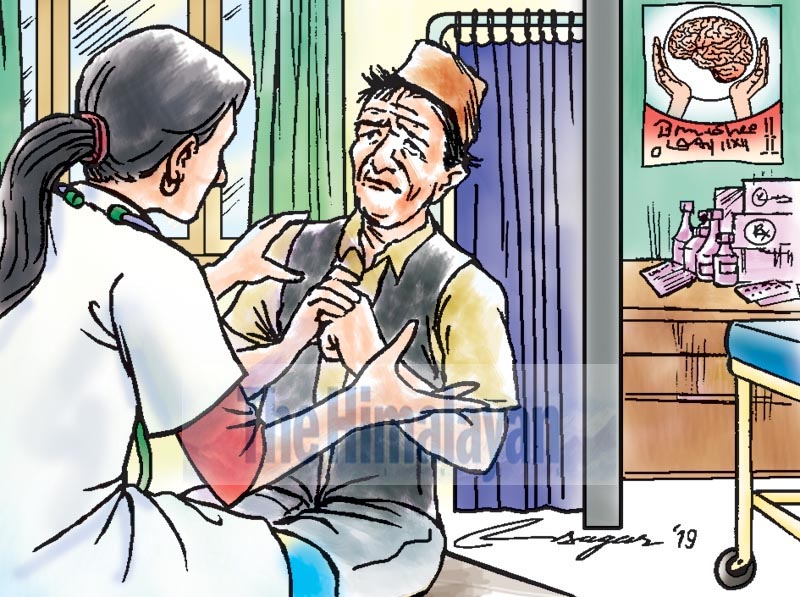Mental illness: Treatable with care
A recently published paper of a nationwide study shows that instances of common mental disorders in Nepal are higher than the global average, with anxiety at almost 23 per cent and depression almost 12 per cent
"Am I mad?” The question was a bit shocking. A 50-year-old man, a government school teacher by profession, was brought by his brother to my OPD for his ‘anxiety’ symptoms. Seeing the board outside my door that read Manochikitsa Bibhag (Psychiatry Department), he was very disturbed and was in no mood to speak to me. Nor could he be convinced to be seen by me. Visibly, he was very angry with his brother for bringing him here. After scanning the room, he said, “Why have you brought me here? Am I mad?”
This is not an unusual scene in my OPD. Such incidents happen regularly in my practice, which is nearing a decade now. My relatives often whisper to me if they wish to make any unofficial appointment for my services. My friends seek a different space (cafe, restaurant, park or their office) if they want me to talk to those close to them. Some want to come to my home for a family visit and bring their “mentally ill” relative along. Sometimes, they even call me outside my OPD room or beyond my duty-hours, and request to see their kin outside the hospital, either in a canteen or in the corridor.
“Will this bahulaha be all right doctor saab?” said my driver, who was driving my car, pointing to a homeless man, most likely suffering from a chronic psychotic illness.
“How can she work in my office, doctor? She may be dangerous… Please provide me with a health certificate so that I can give her retirement…,” said a senior officer when talking about his personal secretary, who was recently diagnosed with “moderate depression”. “Oh! The guy may commit suicide and cause me trouble…” said a local politician, when talking about his servant (a young guy) who was admitted for his drinking problem.
Nobody wants to take our name as a doctor. I don’t understand why ‘we’ remain a subject of taboo, why ‘psychiatry’ is still a stigma, why derogatory terms like mad, insane, psycho, paagal, moron are still being used so much and so often, and why “mental illness” still remains unacceptable in our society? I understand that laymen, villagers and the uneducated public don’t know any better, but even teachers, officers, bankers and graduates fail to understand that not all mental illnesses are ‘psychosis’, or madness.
Mental illnesses have now been accepted as a type of disease, with mild to severe grades in terms of severity variations and treatment responses. Some are mild emotional reactions (grief, adjustment disorders) requiring just timely counselling while others - schizophrenia, mania and severe depression - may require hospitalisation and prolonged care. Some (like mild to moderate depression or anxiety) may be relieved by a short course of antidepressants, while others like bipolar disorder may require long-term - even lifelong - maintenance treatment.
How can the public be educated about this? It’s ironic that doctors seem ignorant regarding mind-body relationships and emotional conditions requiring treatment. Even my colleagues, who are senior doctors, do not understand the significance of treatment in various psychiatric illnesses. One of my patients, a medical student requiring long-term psychiatric medication, once came to tell me that his teacher - a senior physician - had suggested that he stop taking psychotropic medications, as they may be “dangerous”.
I remember one medical officer panicking in front of me when he found the patient he was talking to had recently used Haloperidol - a neuroleptic medicine used for psychotic conditions. I don’t understand why even doctors label psychotropic medicines as ‘dangerous’ and psychotics as ‘harmful’. How can the stigma and prejudice against the mentally ill be reduced in the community at large? I remember the results of some research I had done around six years ago, which found that attitudes towards psychiatry and mental illnesses among the medical students were relatively negative. This is true because our course-designers - so called intellectuals - fail to understand the significance of psychiatry teaching.
We aim to produce a medical graduate who will be able to independently handle a Primary Health Centre (PHC). Around 300 PHCs in the country could then ultimately be taken care of by 300 MBBS doctors. But the curriculum has not been designed in a manner that allows future doctors to recognise at least some common mental disorders, like anxiety and depression.
Our recently published paper of a nationwide study shows that instances of common mental disorders in Nepal are higher than the global average, with anxiety at almost 23 per cent and depression almost 12 per cent. Isn’t this evidence enough to awaken our policy-makers or curriculum-designers to realise how important teaching psychiatry to our undergraduates is?
If we prepare a few batches of medical graduates who have some knowledge of ‘mental health’, they could be utilised as our ambassadors to educate the public that all anxious or depressed or alcohol-dependent or grief-driven or stress-shaken individuals are not mad. We could teach them that the so-called madness is treatable; it just needs empathic understanding and directed care.
Having said that, I still have no answer to the senior teacher, who asked his brother, ‘Am I mad?” in front of my OPD door.
Dr Risal is a psychiatrist






